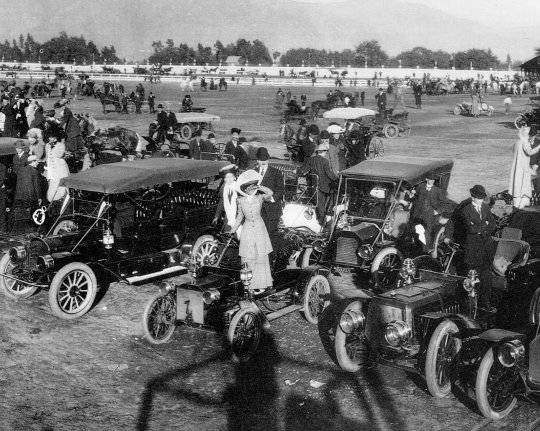 |
| Photo of Tournament Park 1909 by
Harold Parker courtesy of Donald A. Parker |
Where is the American?
By Jake Brouwer
The lines were cut at exactly 3:00 in the afternoon and the balloon American rose to the skies. Its flight seemed destined for trouble at the outset for just outside the fence of Tournament Park the drag rope wrapped around three electrical wires and held the balloon captive. As the crowd looked on a ground crew came to the assistance of the American and freed the balloon for its afternoon ride. With all the commotion going on the pilot, Captain Augustus E. Mueller failed to notice that the wind sock was no longer tailing towards the east as their trip plan required but to the north towards the San Gabriel Mountains.
 |
| Photo of Tournament Park 1909 by
Harold Parker courtesy of Donald A. Parker |
It was March 20, 1909 and thousands of people crowded the streets of Pasadena that day to celebrate the 20th anniversary of the Tournament of Roses. Afterwards folks would gather at Tournament Park to witness horse races, chariot races, football games, view the horse drawn floats, and on this particular day there was to be a balloon race between the American and the United States. The owner of both balloons, Dick Ferris, was to pilot the United States in the race. Ferris however was dismayed by the weather conditions on Friday and canceled the race.
Captain Mueller was not one to be put off by a few dark clouds off in the mountains to the north. It was sunny in the morning, the skies were clear to the east, and after all it was the last day of the carnival. Mueller optimistically set out to inflate the balloon. Surely there will be some that will ride the winds with me today.
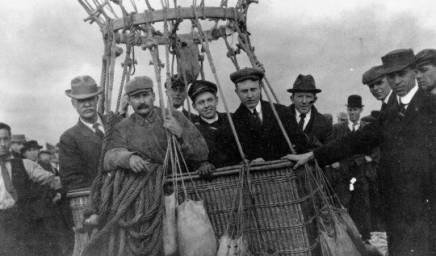 |
| The Captain and his passengers ready
for take off in the balloon American. Photograph from the Harold Parker collection. courtesy of Donald A. Parker |
Richard C. Halsted rode in the balloon earlier that week and gathered together four other men to pay the $25.00 fee for today’s ride. The other passengers were Lane C. Gilliam, Sydney Cray, Edwin Dobschultz, and photographer Harold A. Parker. At 2:30 the six men climbed in the balloon and after dealing with the ropes being caught up the wires they were finally up, up, and away. As they drifted along in free flight the drag rope of the American touched the tops of the trees in the orange groves north of the park. Mueller had a sandbag dropped overboard and the American gained elevation.
Thirty-year-old Parker brought with him his new Kodak bellows camera. This modern wonder used roll film and was promoted as being a "vest pocket model." As the balloon rose Parker snapped the first aerial pictures of Pasadena.
The passengers were quite occupied with pointing out familiar sites to each other while Mueller remained silent. He was aware that the balloon was traveling north instead of east. Instead of turning back at this point he chooses to toss out more sandbags and gain altitude, rather than be the laughing stock of his peers by landing shortly after take off.
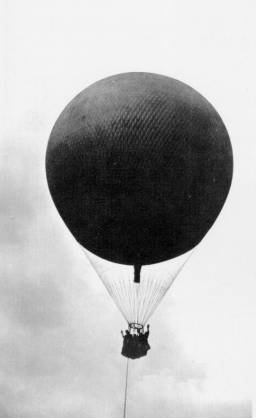 |
The American ascends. Photo Harold Parker Collection courtesy Donald A. Parker |
The balloon soon appeared to be being sucked into Eaton Canyon and then skirted the edge of the mountains. Sydney Cray, a local sportsman and pigeon rancher, spotted Echo Mountain and the Incline Railroad below. Dark clouds were hanging ominously in the upper reaches of the canyons. Next the balloon passed Camp Sierra further to the west. The passengers suggested landing there but as the ropes actually touched the tops of the tents and cabins, captain Mueller saw dangerous camp fires and threw out more ballast shooting them into the clouds.
That was the last folk’ back home saw of the American. Speculations ran from the balloonists landing on one of the crags on the valley side of the range, to Mueller gaining more altitude and crossing the range into he desert on the other side. The Pasadena office of the Southern Pacific Railroad sent out telegraphic inquires to Palmdale, Lancaster and other stations along the SPRR line.
Professor Thaddeus Lowe of the Mt. Lowe Railroad, and a balloonist in his own right, dashed these theories, saying that the air moves in waves and the danger of being tossed against the mountains was extreme. Also at the elevations necessary to make a crossing the air is very cold and it causes the balloon to lose his lifting power.
Page 10 of the Los Angles Times Sunday morning the 21st gave an accounting of the balloon last being sited below Alpine Tavern. Anxiety was increasing and the tension mounting as rain began to fall in Pasadena and reports of snow at Mt. Wilson were coming in.
By Sunday afternoon search parties were being organized. Reports of sightings had came in from Camp Sierra, the train dispatcher at Echo Mountain Station, and a ranger in Sierra Madre. These were tabulated and entered into the search plans.
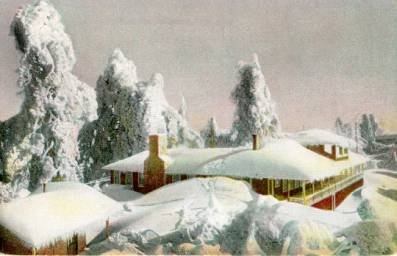
By now though the temperatures were below freezing and reports came in of four feet of snow at Mt. Wilson. Alpine Tavern reported two feet of the powder and said the visibility was less than one hundred feet. One party headed out from the tavern Sunday afternoon but had to turn back when the snow on the trails became waist deep. Other search groups also held off due to the blizzard like conditions in the mountains.
On Monday morning the Pasadena Daily News proclaimed; PASADENANS MAY HAVE PERISHED IN BALLOON. When the weather cleared the search parties headed for the mountains. One group went in the mouth of the Arroyo Seco and headed towards Switzers Camp, another group was to enter from Mt. Wilson. Roy Knabenshue, another balloonist, took off Monday morning on a train into Rubio Canyon and then rode to the top of the Great Incline where he waited while the crews cleared the tracks of snow on the Alpine division.
.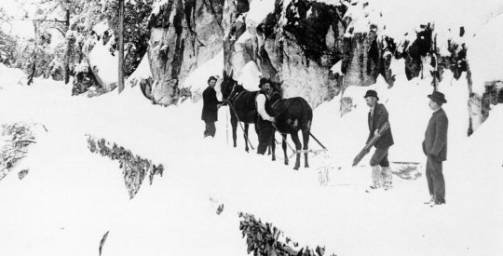
Four experienced mountaineers joined him on a specially dispatched train to the tavern. Once at the tavern the men warmed themselves by the grand fireplace. Then they headed out in waist deep snow along side Mt. Lowe and Mt. Markham. They shouted at every ravine and hollow hoping to hear a response back. They headed into Bear Canyon and were stopped finally by water and snow five feet deep. The next morning they set out again into the headwaters of Millard Canyon and followed it all the way down to Dawn Mine. Finally the men took the trail back up to the tracks and rode the train back into the city exhausted.
The electric plant agreed to blow its whistle when word was received of the balloon crew. Two long blasts meant the group had been found alive. Four short blasts indicated they were found but that some had perished. Monday came and went with no blast from the power plant, as did Tuesday morning. That morning the story was headlined in New York, Chicago, Baltimore, and the Los Angeles papers, the Tribune and the Times.
WHERE IS THE AMERICAN?
When the ballast was thrown from the balloon on Saturday the 20th the basket and its passengers shot up into the darkness at thirteen thousand feet. Bolts of lightning lit up the sky above the clouds. There was hail and it was freezing cold. The group decided it would be best to try to land. Mueller agreed and released gas from the bag. Rapidly the balloon descended and most of the men gasped for breath. As they popped through he clouds at seven thousand feet a jagged peak was seen with a small plateau to the left. They aimed for the clearing and the balloon alighted softly. The men grabbed onto brush to hold the basket steady as the giant bag settled across the bushes and rocks off the side. No one was hurt and the ride was over at 4:15 PM, just one hour and fifteen minutes after take off!
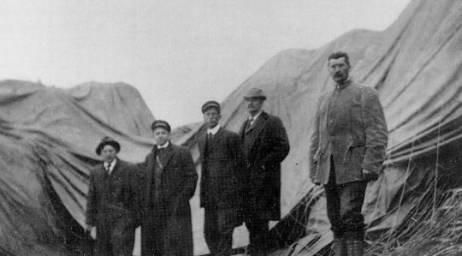 |
| Photo of the landing site taken by
Harold Parker with his Kodak Vest Pocket Camera. courtesy of Donald A. Parker |
The photographer, Parker, takes a shot of the group by the fallen balloon and then the group ties it off so it can be retrieved later. An accounting of their gear shows only a rope and a smashed basket of food provided earlier by the Maryland Hotel. No compass and very low visibility sets the intrepid travelers off in different directions to search for a way out of their predicament. Parker headed to the north quickly returning saying a sheer cliff was not more than twenty feet away. Cray found a canyon that they all decided to follow into single file. Later it was determined to be Grotto Canyon. It was raining and the group made use of the rope working their way down into the canyon. The vegetation got thicker as they went on and soon they had to settle in for the night.
At a small flat area in the canyon called the group found that by moving the wet pine needles aside, dry ones were underneath. One match was found amongst them and it was cautiously used to light the needles, some shavings and a crumpled piece of cigarette paper. They rationed the food into thirds and ate one third of it.
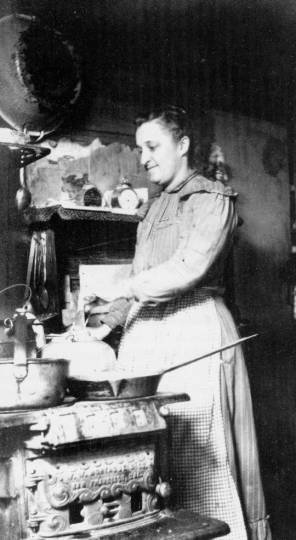 Sunday morning they continued down the canyon though the
water in the widened stream was now waist deep. Soon a crashing
of water was heard and it was realized none to soon a waterfall
was ahead. Closer investigation led them to discover a 30-50 foot
fall. It begins to hail again and rain was coming down in sheets.
The men had to head back up the canyon the way they had come.
Halsted at one point falls completely into the water and the
others with no regard for themselves go in after him. Cold and
drenched the six men continue on soon finding a snow-covered
trail and a stump of a tree that had been recently cut. Another
thirty minutes up the trail and they smelled smoke and came upon
a pen for cattle or pigs. All was not lost. At last they saw a
house with smoke pouring from the chimney.
Sunday morning they continued down the canyon though the
water in the widened stream was now waist deep. Soon a crashing
of water was heard and it was realized none to soon a waterfall
was ahead. Closer investigation led them to discover a 30-50 foot
fall. It begins to hail again and rain was coming down in sheets.
The men had to head back up the canyon the way they had come.
Halsted at one point falls completely into the water and the
others with no regard for themselves go in after him. Cold and
drenched the six men continue on soon finding a snow-covered
trail and a stump of a tree that had been recently cut. Another
thirty minutes up the trail and they smelled smoke and came upon
a pen for cattle or pigs. All was not lost. At last they saw a
house with smoke pouring from the chimney.
Halloo! Ma and Delos Colby heard the noise and on investigation they were surprised to see a group of frozen men in business suits. Realizing quickly their predicament the colbys, took in the strangers and gave them sanctuary from the elements. Their clothes were removed and hung to dry across the room. Ma Colby pulled out all the stops when it came to feeding the men whom hadn’t eaten for 24 hours. They told of their flight and though Delos Colby disagreed at first, it was determined they had landed near Strawberry Peak one of the most jagged peaks in the San Gabriels.
On Monday the men rested most of the day, as the weather was so bad Delos would not guide them out to Switzers the location of the nearest phone.
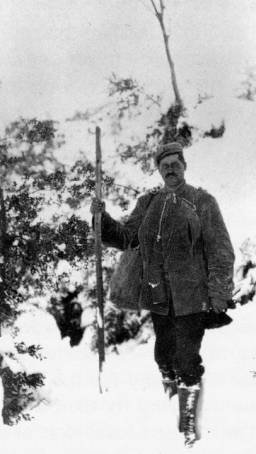 |
Captain Mueller on the snowy trail Tuesday March 23, 1909. Photo by Harold Parker, courtesy of Donald A. Parker |
Tuesday morning the weather broke and Delos Colby guided the men to the trail that would take them over to Switzers Camp. Colby would not go all the way himself. The men broke the trail Indian style and at 2:30 Tuesday afternoon the search party resting at Switzers heard another "HALLOO!" The balloon party had reached Switzers. They were quickly rushed inside to warm by the fire and promply had to field a barrage of questions from the press.
A phone call was made to the paper and another to the power plant and before long across the valley two long blasts of the steam whistle blew. The entire balloon party was safe!
This is a book that needs to be read by all Echo Mtn. Echoes subscribers. It contains wonderful clips of history in the Pasadena area and a factual accounting of a real life event in our history that captivates the reader from beginning to end. My thanks to Donald L. Parker for allowing me to use photos and excerpts of his book, PERILOUS VOYAGE OF THE BALLOON AMERICAN, in order to bring this story to you. Also thanks to Harold A. Parker for his insight to photograph the event and to his wife and descendants for maintaining a scrap book to be the source of inspiration for Donald Parker to write this wonderful book.
THE PERILOUS BOOK OF THE BALLOON AMERICAN can be found at Dawsons Books and at Vromans Books. Local libraries have it as well as the Altadena Historical Society.
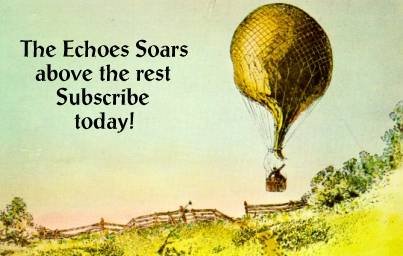
Visit Echo Mtn. Echoes SUBSCRIBE page.
Send email to Echowebmaster@aaaim.com to report any problems.
Last modified: February 12, 1999
No part of this paper may be
reproduced in any form without written permission from:
Jake Brouwer
All articles and photos were provided by:
Land-Sea Discovery Group
Copyright © 1999